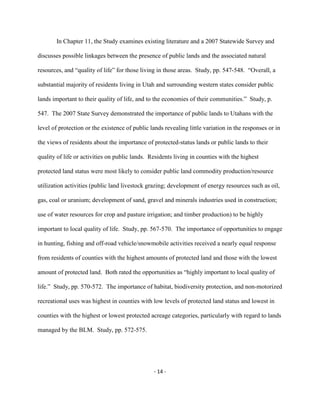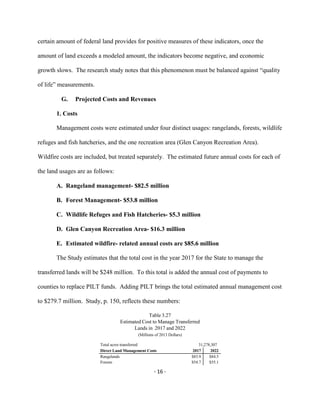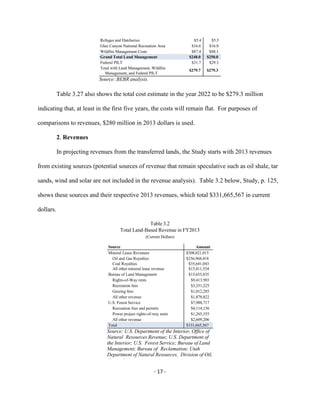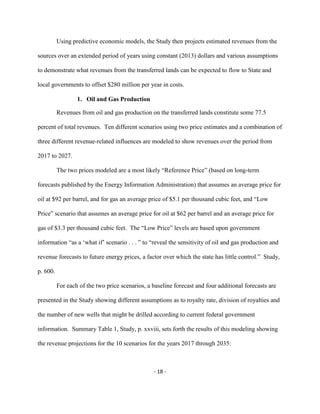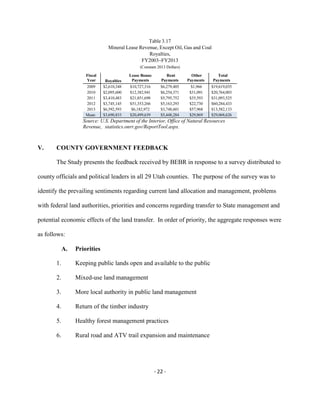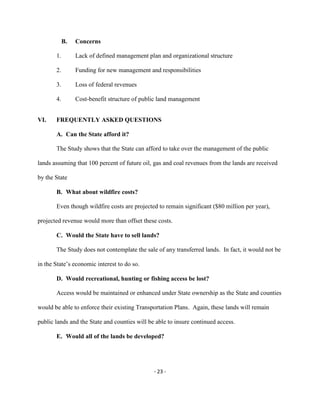This document provides a summary and analysis of a study examining the potential impacts of transferring federal public lands in Utah to state ownership. Some key findings of the study include:
1) Revenues from activities on BLM and Forest Service lands averaged $317.6 million and $7.9 million annually, respectively, while management costs averaged $118.6 million for BLM lands and $93.9 million for Forest Service lands.
2) Wildfire suppression costs averaged $33.4 million annually over the past decade, with federal spending averaging $27.6 million and state spending $5.8 million.
3) Revenue sharing programs like PILT and SRS provided around $46 million to local

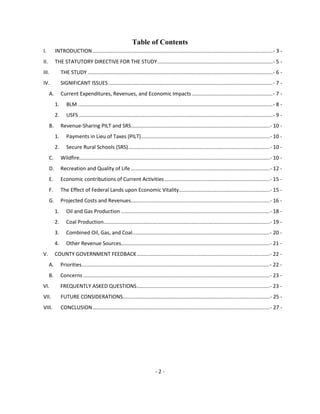



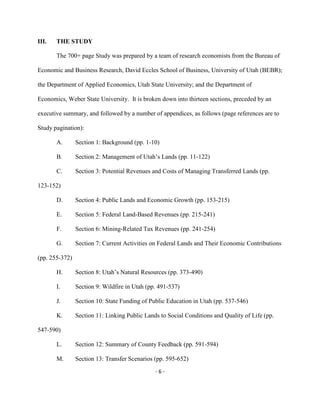

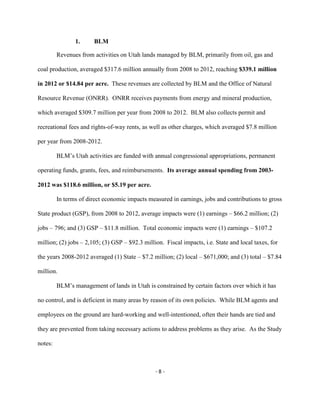
![BLM’s management decisions are constrained by budget considerations and a
complex regulatory environment. While the overarching goals and principals
[sic] governing management of public lands are provided in FLPMA, the BLM
must also incorporate a plethora of other—and sometimes conflicting—laws and
regulations in its management objectives, all while accommodating public
demands for access and use.
Study p. 41.
2. USFS
USFS collects revenues from a number of activities including recreation, grazing, sales of
mineral resources and forest products, land use for power generation, and ski resort operations.
Revenues are divided into two groups: (1) receipts from commercial activities, and (2) fees.
Revenues from commercial activities go to the National Forest Fund (NFF). Fees are paid into
special accounts and trust funds. In 2012, $7.9 million in revenues were generated by Utah
Forests, $5.2 million of which went to NFF and $2.7 million in fees. These numbers do not
include oil and gas or coal revenues as these activities are managed by BLM.
Because of USFS accounting practices, the costs of management cannot reliably be
allocated to specific states. Accordingly, spending and employment reflected in the Study relate
only to the 5 national forests that are exclusively in Utah. Average spending over the period
from 2008 through 2012 was $93.9 million or $11.04 per acre. In 2012, USFS spent $102
million or $12.05 per acre, managing Utah forests, of which $51.1 million was paid in
wages; 987 people were employed at the forest level.
In terms of direct economic impacts, over the period 2008 through 2012, average impacts
from USFS activities were (1) earnings – $77.9 million; and (2) jobs – 1,365. Total economic
impacts were (1) earnings – $108.9 million; (2) jobs – 2,384; and (3) GSP – $64.5 million.
Fiscal impacts (taxes) for this period averaged (1) State – $7.28 million; (2) local – $681,910.
- 9 -](https://image.slidesharecdn.com/utaheconomicanalysissummary-141218133350-conversion-gate02/85/Summary-of-Utah-economic-analysis-9-320.jpg)

![million; State annual fire suppression costs averaged $5.8 million. See Study, Table 9.12, p. 510.
During 2004-2008, USFS spent 54.7 percent of its fire suppression costs in the West on aircraft
or firefighting services, for which USFS bears a large share. A land transfer could result in
FFSL “losing access to federal aircraft suitable” for fire suppression and could “raise state costs
above current levels.” As of 2014, federal land managers also paid about 80% of Utah’s $2.5
million annual assessment for the services of the National Interagency Coordination Center
(NICC).
During 2008-2012, most wildfire spending ($52.2 million per year, (97.3%)) for
mitigation, preparedness and rehabilitation (non-suppression costs) came from federal agencies.
FFSL contributed $1.4 million annually. Study, p. 513. Non-suppression expenditures by USFS
averaged $2.48/acre; BLM, $1.38/acre; and FFSL, $0.06/acre.
Post transfer, Utah “may require an estimated $25.9 million increase in state funding for
fire suppression for an additional 31.3 million acres of federal lands (Table 9.9)….Furthermore,
for wildfire-related expenses besides suppression, state costs may rise an additional $50.8 million
for a total estimated $76.7 million in new wildfire management costs.” Study, p. 509. This
increase is based on the assumption that the State would continue the same wildfire management
practices currently employed by BLM and the USFS. Id.
The Study suggests some alternatives by which wildfire costs could be reduced or
revenue increased to meet increased costs. Changes in fire suppression approaches and
mitigation could allow for management at lower costs. “[L]and managers can actively manage
forests and rangelands and regulate the wildland-urban-interface to make them less vulnerable to
dangerous fires.” Study, p. 491. Zoning measures “to direct new construction to defensible
areas,” and the requirement that homeowners install fire-safe landscaping and use fire-safe
- 11 -](https://image.slidesharecdn.com/utaheconomicanalysissummary-141218133350-conversion-gate02/85/Summary-of-Utah-economic-analysis-11-320.jpg)
![construction materials, are suggested as strategies for fire prevention and reducing fire
suppression costs. Post-transfer alternatives for aircraft services include, creating a State fleet,
leasing through private contracts, using the National Guard and its equipment, or continuing to
request support through the NICC.
The Study observes that “[s]ustainable management of resources uses such as timber
harvesting and livestock grazing is compatible with healthy vegetation and normal wildfire
activity. Harvesting, prescribed burns and preparedness can reduce the severity and cost of
wildfire.” Study, p. 506. As of 2005, 3.6 million acres of timberland in Utah (77%) had timber
in excess of prescribed USFS forest conditions. Study, p. 526. Removal is recommended for
about 38% of the total volume of timber standing in Utah forests with commercially viable trees.
The Study concludes “[s]uppression and post-fire restoration costs are only part of the true cost
of wildfire. Prospects of property losses, personal harm, environmental degradation, and a
variety of other economic and noneconomic costs from wildfire would make the argument for
prescribed burns and mechanical treatments more compelling.” Study, p. 531-532.
D. Recreation and Quality of Life
The Study contains a review of data regarding the importance of recreation activities to
the Utah economy (Chapter 7), Study, pp. 257-289; and information from a comprehensive
survey of research literature and a 2007 statewide survey of Utah residents conducted by Utah
State University (2007 State Survey) regarding certain “quality of life” issues (Chapter 11).
Study, pp. 547-590. Among other things, the Study concludes, “Outdoor recreation is part of
Utah’s culture and heritage, and preserving such opportunities enhances the quality of life for
residents and visitors ….The State values preserving its natural surroundings, and recognizes that
the natural environment and the abundance and diversity of outdoor activities contribute to the
- 12 -](https://image.slidesharecdn.com/utaheconomicanalysissummary-141218133350-conversion-gate02/85/Summary-of-Utah-economic-analysis-12-320.jpg)
![Utah economy." Study, p. 257. Further, Utahans overwhelmingly agree that public lands are
important in defining the culture and heritage of their communities, and in providing areas where
they can pursue the activities they enjoy most. Another section of the Study notes that access to
roads and trails on the public lands is important for many recreation activities. The Study
concludes that “access to roads and trails would increase following land transfer . . . the state
would likely be more permissive than federal land managers in this regard.” Id.
Chapters 7.1 and 7.2 discuss recreation, in general, and wildlife-related recreation
(hunting, fishing, and wildlife watching), in particular. According to the Study, “[T]he total
benefit of recreation and travel in Utah is approximately $16.9 billion; this consists of consumer
spending of $9.8 billion, and an overall net benefit to Utah residents of approximately $7.1
billion.” Study, p. 276. The U.S. Fish and Wildlife Service (USFWS) estimates that more than 1
million people, aged 16 and older, participated in wildlife-related recreation in Utah during 2011.
Study, p. 277. “Expenditures by resident and nonresident hunters, fishers and wildlife viewers
supported 11,815 jobs with $340.6 in earnings and contributed $657.2 million to gross state
product in 2011.” Study, p. 289; See also Table 7.19, p. 289. Improved access that might be
provided by the State is also important for wildlife recreation. “Post-transfer , the state could re-
evaluate access by hunters, anglers and DWR personnel to transferred lands, particularly WSAs
and those not well served by approved travel plans.” Study, pp. 108, 113. The Study uses
nonmarket valuation methods to measure recreational and environmental values. “[V]aluation of
environmental quality demonstrates that the environment provides utility to individuals in much
the same way as market goods and services.” Study, p. 261. Additionally, “[t]he opportunity to
recreate and have access to lands is important even if the opportunity is not realized.” Study, p.
xxix.
- 13 -](https://image.slidesharecdn.com/utaheconomicanalysissummary-141218133350-conversion-gate02/85/Summary-of-Utah-economic-analysis-13-320.jpg)
